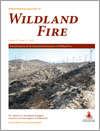International Journal of Wildland Fire
Volume 27
Number 12 2018
On state and federal lands in California fire frequency increased steadily from the early 1900s and then declined dramatically since 1980. Humans were the dominate source of fires and some ignition sources have declined in recent decades with the exception of powerline ignited fires.
A systematic approach to grass fire modelling using a physics-based model through the establishment of the atmospheric boundary layer and grid convergence is presented. A successful reference case simulation is followed by a study of grass fire cases that tests the effects of wind speed and grass height independently. A correlation for the rate of spread as a function of grass height is proposed.
We used a time series approach (1985–2017) to evaluate the post-fire (1986–1997) change in greenness for conifer forests across the United States Rocky Mountains. We found that examining trends in post-fire greenness in both the growing season and snow-cover season allowed us to isolate conifer species, improving our understanding of both the pre-fire and post-fire vegetation condition.
One of the objectives of a fire management program for commercially managed forests is to reduce economic losses. We found that an increase in presuppression expenditure can reduce the area burned and thereby increase the net revenue from primary-processed wood products with the timber that otherwise would have burned.
We present a novel metric with which to assess fire severity in a heathland ecosystem. We found that by studying the reflectance of charcoal, we not only acquire a quantitative measurement of fire severity, but also a higher-resolution dataset than qualitative fire severity metrics can currently provide.
Agassiz’s desert tortoises and their habitat are poorly adapted to fire. Wind energy facilities occasionally cause turbine-induced fires. We studied the activity areas and behaviour of tortoises before and after two such fires. Site fidelity by tortoises exposes them to unfavourable habitat with less nutritious food plants.





